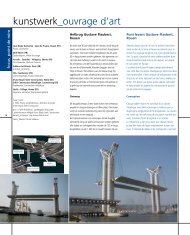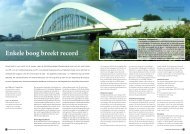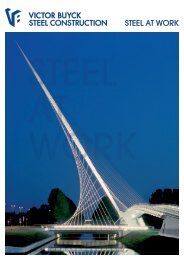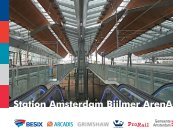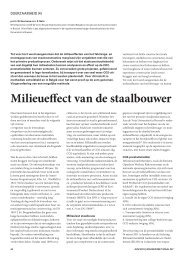environmental implications of steel bridge construction
environmental implications of steel bridge construction
environmental implications of steel bridge construction
Create successful ePaper yourself
Turn your PDF publications into a flip-book with our unique Google optimized e-Paper software.
In order to qualify for the highest level 5, the company is required to demand a CO2 emissions<br />
inventory for scope 1 and 2 in accordance with ISO 14064-1 or equivalent from its A<br />
suppliers. Furthermore, the company should have, and should report upon, quantitative reduction<br />
objectives for scope 1, 2 and 3 (other indirect emissions such as due to paper use and<br />
waste disposal). The monitoring <strong>of</strong> progress with regard to these objectives has to be incorporated<br />
into the normal planning and control cycle. The company is required to commit itself<br />
publically to a CO2 reduction programme operated by the government or an NGO and to actively<br />
participate in the setting up and implementation <strong>of</strong> a (sector-wide) CO2 reduction programme<br />
in collaboration with the government and/or NGO.<br />
In evaluating tenders for <strong>construction</strong> works, ProRail translates the level <strong>of</strong> performance<br />
ladder into an ‘award advantage’. The higher the level on the certificate, the greater the advantage<br />
the company gains in the award weighting. If a company has been certified level 3,<br />
this (fictitious) advantage is 4%. For level 5, this is 10%.<br />
In order not to lose out on competition, it is therefore important for <strong>steel</strong>work contractors<br />
to master with this type <strong>of</strong> regulation. Victor Buyck Steel Construction (located in Eeklo-<br />
Belgium) has been one <strong>of</strong> the first <strong>steel</strong>work contractors to get certified level 3. As such, and<br />
in order to qualify for level 5, this <strong>steel</strong>work contractor has participated with the research into<br />
the <strong>environmental</strong> impact <strong>of</strong> the fabrication and erection <strong>of</strong> <strong>steel</strong> structures.<br />
2. RESEARCH APPROACH<br />
The research focuses on information modules A.4 and A.5 <strong>of</strong> EN 15804 [2], which represents<br />
the <strong>construction</strong> process stage (transport from <strong>steel</strong> mill to fabrication yard and the <strong>construction</strong><br />
& installation process).<br />
The whole fabrication and erection process has been divided into 5 groups <strong>of</strong> (in total 85)<br />
single activities and (roughly 200) individual factors:<br />
1. Fabrication<br />
including pre-blasting, preparation (oxy-cutting <strong>of</strong> plates, cutting <strong>of</strong> pr<strong>of</strong>iles, drilling,<br />
punching, assembling, welding, manipulation, etc.);<br />
2. Corrosion protection<br />
including blasting, painting, and (in case) metal spraying;<br />
3. Transport<br />
including both external transport (from the <strong>steel</strong> mills and to the <strong>construction</strong> site)<br />
and internal transport;<br />
4. Erection<br />
including site welding, gas and fuel consumption, cranes, etc.;<br />
5. Overhead<br />
which represents <strong>of</strong>fice consumption (electricity, heating) and heating, ventilation<br />
and lighting <strong>of</strong> the workshops.<br />
For each single activity, the energy consumption (expressed in MJ) and the global warming<br />
impact (expressed in kg CO2 equivalent) have been determined.



